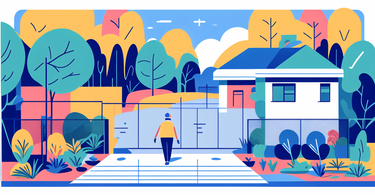The Impact of New Privacy Fence Regulations on Homeowners
Understanding the Regulatory Changes
Recent changes in privacy fence regulations have left many homeowners puzzled. These new rules aim to balance privacy needs with community aesthetics. Key changes include height restrictions, material guidelines, and placement rules. Many areas now limit fence heights to 6 feet in backyards and 4 feet in front yards. Some towns require permits for new fences. Material restrictions often favor natural wood over vinyl or metal. Setback rules ensure fences don't encroach on property lines or public spaces. It's crucial for homeowners to check local laws before starting any fence project.

Navigating Compliance and Installation Requirements
Complying with new fence rules can be tricky. Here are some steps to ensure your project meets regulations:
- Research local zoning laws
- Obtain necessary permits
- Choose approved materials
- Hire licensed contractors
- Follow height and placement guidelines
- Consider neighbor input
Many cities offer online resources or consultation services. These can help clarify rules and avoid costly mistakes. Some areas require professional installation for certain fence types. Others mandate inspections before and after installation. Planning ahead can save time, money, and potential legal issues.
The Importance of Staying Informed
Keeping up with changing fence laws is vital for homeowners. Rules can vary widely between cities or even neighborhoods. Homeowners' associations often have their own fence guidelines. These may be stricter than local laws. Staying informed helps avoid fines or forced removal of non-compliant fences. It also ensures your investment in privacy is protected. Regular checks with local authorities can keep you updated on any changes. Joining community groups or forums can provide valuable insights from other homeowners.
Technological Advancements in Privacy Fencing
Innovations in Materials and Design
The world of privacy fencing has seen exciting innovations recently. New materials offer better durability and aesthetics. Composite fences blend wood fibers with recycled plastics. They resist rot, insects, and fading better than traditional wood. Some new fences use modular designs for easy installation and replacement. Others feature textured surfaces that mimic natural materials. Sound-absorbing fences are gaining popularity in urban areas. They reduce noise pollution while maintaining privacy. Solar-powered lighting options are now available for fence tops and posts. These add security and ambiance without increasing energy bills.

The Role of Smart Fences in Enhancing Privacy
Smart technology is transforming privacy fences. These high-tech barriers offer more than just visual privacy. Some smart fences include motion sensors and cameras. They can alert homeowners to potential intruders. Others have built-in speakers for music or communication. Climate sensors can adjust fence panels to optimize airflow and shade. Some systems integrate with home automation platforms. This allows remote control of gates or lighting. Privacy settings can be adjusted based on time of day or occupancy. While pricey, these features offer unparalleled control over outdoor spaces.
Considering the Balance Between Privacy and Security
Modern fences must balance privacy with security needs. Too much privacy can create blind spots that attract criminals. Too little defeats the purpose of a privacy fence. New designs aim to find middle ground. Some fences have clear upper sections to maintain sightlines. Others use strategic placement of solid and open sections. Lighting plays a crucial role in this balance. Motion-activated lights deter intruders without constant brightness. Reflective elements can enhance visibility at night. The key is creating a sense of security without feeling closed in.
Case Studies: Privacy Fence Installation Success Stories
Residential Projects: Transforming Outdoor Spaces
Many homeowners have successfully navigated new fence regulations. In Seattle, the Johnson family installed a 6-foot composite fence. It met height restrictions while providing full privacy for their backyard pool. They chose a natural wood grain finish to comply with material guidelines. In Miami, the Garcias opted for a living fence. They planted fast-growing bamboo along their property line. This natural barrier met eco-friendly requirements in their neighborhood. Both families report increased property value and improved quality of life. These projects show how creativity can meet both regulatory and personal needs.

Commercial Developments: Maintaining Privacy and Aesthetics
Businesses face unique challenges with privacy fencing. A Texas office park recently installed smart fencing around its perimeter. The system includes retractable sections for easy emergency access. It also features noise-cancelling technology to reduce traffic sounds. In California, a winery used decorative metal fencing with climbing vines. This solution met privacy needs while enhancing the property's natural beauty. Both projects required careful planning to meet local codes. They demonstrate how commercial spaces can achieve privacy without sacrificing aesthetics or function.
Legal Considerations in Privacy Fence Installation
Legal issues often arise with fence installation. A recent case in Oregon highlights the importance of proper planning. Two neighbors disputed the placement of a privacy fence. The court ruled in favor of the fence owner, who had followed all local regulations. In contrast, a Florida homeowner faced fines for installing an oversized fence. They had to reduce the height to comply with local laws. These cases stress the need for thorough research before starting any fence project. Consulting with lawyers or local officials can prevent costly mistakes. It's also wise to communicate with neighbors to avoid potential conflicts.
